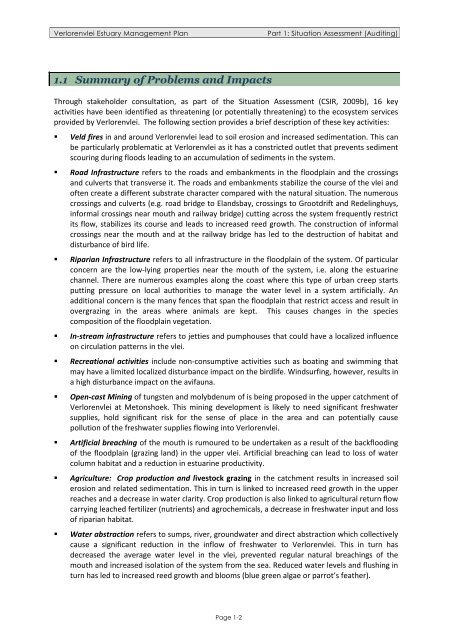Download PDF - Anchor Environmental
Download PDF - Anchor Environmental
Download PDF - Anchor Environmental
Create successful ePaper yourself
Turn your PDF publications into a flip-book with our unique Google optimized e-Paper software.
Verlorenvlei Estuary Management Plan<br />
Part 1: Situation Assessment (Auditing)<br />
1.1 Summary of Problems and Impacts<br />
Through stakeholder consultation, as part of the Situation Assessment (CSIR, 2009b), 16 key<br />
activities have been identified as threatening (or potentially threatening) to the ecosystem services<br />
provided by Verlorenvlei. The following section provides a brief description of these key activities:<br />
• Veld fires in and around Verlorenvlei lead to soil erosion and increased sedimentation. This can<br />
be particularly problematic at Verlorenvlei as it has a constricted outlet that prevents sediment<br />
scouring during floods leading to an accumulation of sediments in the system.<br />
• Road Infrastructure refers to the roads and embankments in the floodplain and the crossings<br />
and culverts that transverse it. The roads and embankments stabilize the course of the vlei and<br />
often create a different substrate character compared with the natural situation. The numerous<br />
crossings and culverts (e.g. road bridge to Elandsbay, crossings to Grootdrift and Redelinghuys,<br />
informal crossings near mouth and railway bridge) cutting across the system frequently restrict<br />
its flow, stabilizes its course and leads to increased reed growth. The construction of informal<br />
crossings near the mouth and at the railway bridge has led to the destruction of habitat and<br />
disturbance of bird life.<br />
• Riparian Infrastructure refers to all infrastructure in the floodplain of the system. Of particular<br />
concern are the low-lying properties near the mouth of the system, i.e. along the estuarine<br />
channel. There are numerous examples along the coast where this type of urban creep starts<br />
putting pressure on local authorities to manage the water level in a system artificially. An<br />
additional concern is the many fences that span the floodplain that restrict access and result in<br />
overgrazing in the areas where animals are kept. This causes changes in the species<br />
composition of the floodplain vegetation.<br />
• In-stream infrastructure refers to jetties and pumphouses that could have a localized influence<br />
on circulation patterns in the vlei.<br />
• Recreational activities include non-consumptive activities such as boating and swimming that<br />
may have a limited localized disturbance impact on the birdlife. Windsurfing, however, results in<br />
a high disturbance impact on the avifauna.<br />
• Open-cast Mining of tungsten and molybdenum of is being proposed in the upper catchment of<br />
Verlorenvlei at Metonshoek. This mining development is likely to need significant freshwater<br />
supplies, hold significant risk for the sense of place in the area and can potentially cause<br />
pollution of the freshwater supplies flowing into Verlorenvlei.<br />
• Artificial breaching of the mouth is rumoured to be undertaken as a result of the backflooding<br />
of the floodplain (grazing land) in the upper vlei. Artificial breaching can lead to loss of water<br />
column habitat and a reduction in estuarine productivity.<br />
• Agriculture: Crop production and livestock grazing in the catchment results in increased soil<br />
erosion and related sedimentation. This in turn is linked to increased reed growth in the upper<br />
reaches and a decrease in water clarity. Crop production is also linked to agricultural return flow<br />
carrying leached fertilizer (nutrients) and agrochemicals, a decrease in freshwater input and loss<br />
of riparian habitat.<br />
• Water abstraction refers to sumps, river, groundwater and direct abstraction which collectively<br />
cause a significant reduction in the inflow of freshwater to Verlorenvlei. This in turn has<br />
decreased the average water level in the vlei, prevented regular natural breachings of the<br />
mouth and increased isolation of the system from the sea. Reduced water levels and flushing in<br />
turn has led to increased reed growth and blooms (blue green algae or parrot’s feather).<br />
Page 1-2
















